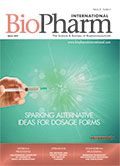Process Validation Sets the Stage for Ongoing Manufacturing Quality
A properly designed validation program will detect variation and ensure control based on process risk.
EtiAmmos/Stock.Adobe.com

Given the critical role that validated commercial manufacturing processes have over ensuring product performance, process validation is an essential product development activity for pharmaceutical and biotechnology organizations. Failure to develop appropriate and effective process validation can lead to substantial regulatory actions by regulatory agencies, which may include recalls, for cause audits, or even plant closures. To assist industry, FDA and the European Medicines Agency (EMA) have published guidance documents that define the general principles of process validation. This article provides a general overview of the requirements of process validation, as described in the process validation guidance documents issued January 2011 by FDA (1) and April 2016 by EMA (2), as well as a comparison of validation requirements for biologics products, which are covered by a biologics license application (BLA), with the validation requirements for small-molecule products, which are covered by a new drug application (NDA).
General requirements
The current good manufacturing practice (CGMP) regulations establish the need for process validation by requiring that drug products be produced with a high degree of assurance of meeting critical attributes, based on objective information and data obtained from laboratory-, pilot-, and/or commercial-scale studies. More specifically, the primary basis for process validation is provided in 21 Code of Federal Regulations (CFR) 211.100(a), which states the requirement for “written procedures for production and process control designed to assure that the drug products have the identity, strength, quality, and purity they purport or are represented to possess ...” (3).
The FDA guidance document provides the general principles and approaches that FDA considers appropriate elements of process validation for the manufacture of human and animal drug and biological products, including APIs or drug substances. Effective process validation as the guidance notes, contributes significantly to assuring drug quality and to meeting the following basic principles of quality assurance: quality, safety, and efficacy should be designed or built into the product; quality cannot be assured only by in-process and finished-product inspection or testing; and each step of a manufacturing process must be controlled to assure that the finished product meets all quality attributes including specifications.
The FDA has defined process validation as “the collection and evaluation of data, from the process design stage through commercial production, which establishes scientific evidence that a process is capable of consistently delivering quality product” (1). The evidence comes from information and knowledge obtained during product and process development and must demonstrate that the commercial manufacturing process will consistently produce APIs and drug products that meet critical quality attributes. A properly designed validation program provides the means for detection of variation and an understanding of the sources and degree of variation; such a program will assure an appropriate level of control of the variation based on the degree of risk to the process and product, where the degree of control of attributes and parameters may be based on the risk to the process and process output. In addition, after the process is confirmed, continued verification activities must be performed to assure the process remains in a state of control when changes are made.
The EMA guidance document contains principles that are generally similar to the FDA guidance with a few notable differences. The EMA guidance specifies that retrospective validation is not acceptable, and that concurrent validation is only acceptable when there is a strong benefit-risk ratio to the patient; the FDA guidance allows for concurrent release of process performance qualification (PPQ), if described and justified in the PPQ protocol, but expects it will be used rarely. Another difference between the two documents is that the FDA guidance has a greater emphasis on the use of statistics. Also, the EMA guidance states that a minimum of three consecutive batches is generally considered acceptable, while the FDA guidance is less proscriptive and allows manufacturers to determine the number of batches needed to demonstrate that the process is sufficiently under control. Both guidance documents outline a lifecycle approach to process validation and emphasize that appropriate quality oversight is essential over the entire validation lifecycle.
Lifecycle approach to process validation
Throughout the product/process lifecycle, established quality attributes and parameters need to be evaluated for their impact on the process, product, and in-process material, and reevaluated as new information becomes available. The FDA and EMA guidance documents each introduced the lifecycle approach to process validation. While the specific validation stages are described using different terms, both documents establish that all attributes and parameters need to be evaluated for their impact on the process, product, and in-process material, and reevaluated as new information becomes available throughout the lifecycle, through the process development and verification activities listed in Table I.
Table I: Process development and verification activities, FDA vs. European Medicines Agency.

In addition, both guidance documents encourage the use of modern pharmaceutical development concepts, quality risk management, and quality systems at all stages of the manufacturing process lifecycle. In particular, FDA guidance provides recommendations that reflect some of the goals of FDA’s initiative entitled “Pharmaceutical CGMPs for the 21st Century–A Risk-Based Approach,” especially with regard to the use of technological advances in pharmaceutical manufacturing, by encouraging the implementation of modern risk management and quality system tools and concepts. The EMA guidance also provides requirements for data to be included in commercial product regulatory submissions.
In Stage 1, process design (FDA) or process characterization (EMA), the objective is to obtain process knowledge and understanding as the basis for establishing an approach to process control for each unit operation and the process overall, including controls for examination of material quality and equipment monitoring. This stage consists of studies to capture and build on process knowledge, which may include early process development experiments, laboratory- or pilot-scale studies, design of experiment (DoE) studies, use of risk analysis tools and/or computer-based simulations, and establishing a strategy for process control by reducing input variability and through appropriate in-process monitoring and operational limits. Advanced strategies may include the use of process analytical technology (PAT) to adjust the processing conditions so that the output remains constant.
In Stage 2, process qualification (FDA) or process development (EMA), the objective is to evaluate the process design to determine whether it is capable of reproducible commercial manufacture. Process qualification (PQ) consists of two elements: design of the facility and qualification of the equipment and utilities; and process performance qualification (PPQ), which combines the actual facility, utilities, qualified equipment, and trained personnel with the commercial manufacturing process, control procedures, and components. CGMP-compliant procedures must be followed, and qualification of equipment and utilities must be performed under quality unit-approved project plan(s) and formal protocol(s). Appropriate facility design must be in place, and commissioning and qualification activities must be completed prior to initiating PPQ. A successful PPQ confirms the process design and demonstrates that the commercial manufacturing process is performing as expected. Following successful completion of PPQ, acceptable, commercial-scale products manufactured during this stage may be released for commercial distribution.
In Stage 3, continued process verification (FDA) or process verification (EMA), the objective is to provide continual assurance that the process remains in a validated state for commercial manufacturing, consistent with 21 CFR 211.180(e), which requires establishment of an ongoing program to collect and analyze product and process data that relate to product quality. This is achieved by establishing a formal, quality unit-approved plan for performing ongoing evaluation activities, which should include:
- A system to detect and characterize variability, detect unplanned departures from the process, and determine root cause
- Monitoring to assess and adjust process variability, as needed
- Collection of data to improve/optimize the manufacturing process
- Maintenance of facility and equipment.
The data collected should include relevant trending for process performance and for the quality of materials/components, in-process material, and finished products; the alert and action limits should be established. The data should be statistically trended and reviewed by trained personnel. The information collected should verify that the quality attributes are being appropriately controlled throughout the process. Continued monitoring and sampling of process parameters and quality attributes should be performed at the level established during the process qualification stage, until sufficient data are available to generate significant variability estimates. These estimates can provide the basis for establishing levels and frequency of routine sampling and monitoring for the particular product and process. Monitoring can then be adjusted to a statistically appropriate and representative level. Process variability needs to be periodically assessed and monitoring adjusted accordingly, both in real time and on an annual basis.
Validation requirements for biologics products
While the FDA guidance document provides general requirements that apply to both small-molecule and biologics products, the EMA guidance document provides specific points to consider for process validation of biologics with regard to the upstream process, the downstream process, and multi-facility production.
For the upstream process, the EMA guidance document provides detailed recommendations on process evaluation and verification activities for the cell culture steps. For the downstream process, the EMA guidance document provides detailed recommendations on process evaluation and verification activities for evaluating the capacity of purification procedures, establishment of adequate analytical methods, process conditions (e.g., column loading capacity, flow rate, column length), and performance parameters. Finally, for multi-facility production, the EMA guidance document provides detailed recommendations for re-evaluation of the process at a new site.
There is also a difference in the validation requirements for biologics products, which are covered by a BLA, with the validation requirements for small-molecule products, which are covered by an NDA. For an NDA, the PPQ must be successfully completed before commercial distribution of a drug product and facilities. In contrast, for a BLA, commercial-scale PPQ must be completed prior to the BLA submission. Also, while in both cases the facility must be ready for inspection at the time of submission, the PPQ data must be included in the BLA submission and facilities must be prepared to manufacture the complete product during pre-licensing inspection (21 CFR 601.4). To facilitate the inspection, manufacturers are expected to submit production schedules approximately two to four months after the BLA submission.
Conclusion
The process validation guidance documents provided by FDA and EMA provide the modern concepts of process validation. The guidance documents establish the lifecycle approach to process validation, encourage the incorporation of risk management principles throughout the product and process validation lifecycle, formally describe the process development activities to perform in order to establish the scientific basis for the process, and provide guidance for an ongoing evaluation of the process to ensure it remains in a state of control during routine commercial production.
References
1. FDA, Guidance for Industry-Process Validation: General Principles and Practices (CDER, January 2011).
2. EMA, Guideline on Process Validation for the Manufacture of Biotechnology-Derived Active Substances and Data to be Provided in the Regulatory Submission (EMA, April 2016).
3. Code of Federal Regulations, Title 21, Food and Drugs, (Government Printing Office, Washington, DC) Part 211.
Article Details
BioPharm International
Vol. 32, No. 3
March 2019
Pages: 40–43
Citation
When referring to this article, please cite it as C. J. Sachs, “Process Validation Sets the Stage for Ongoing Manufacturing Quality," BioPharm International 32 (3) 2019.

Tokyo University of Science Research Team Explores Improved Delivery of Antisense Oligonucleotides
April 18th 2025Using cholesterol-modified oligonucleotides, the research team aims to improve the delivery of antisense nucleotide-based therapies for treating neurodegenerative diseases and brain cancers.
Teva and Samsung Bioepis Launch Biosimilar Eculizumab in US Market
April 17th 2025Eculizumab-aagh (EPYSQLI) is now available in the US to treat patients living with difficult-to-treat rare diseases such as paroxysmal nocturnal hemoglobinuria, atypical hemolytic uremic syndrome, and generalized myasthenia gravis.